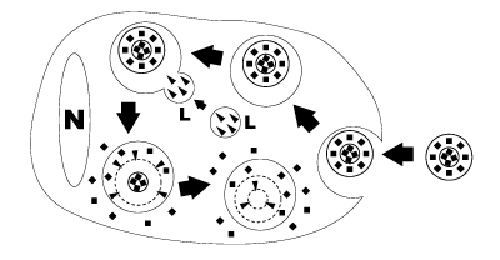Mechanism of action
Macrophages play an important role in immune and non-immune defence mechanisms. They form a first line of defence against bacterial, viral and other forms of microbiological contamination penetrating into the bodies of vertebrates. Macrophages are large cells, found in almost all bodily tissues where they can have varying forms and names (e.g. Kupffer cells, alveolar macrophages, microglia, osteoclasts, red pulp macrophages). Macrophages “scavenge”, they ingest and digest all foreign substances, microbes, cancer cells and cellular debris that might be potential pathogens. This process is called phagocytosis. Macrophages further regulate functions of many non-phagocytic cells, mainly through mediation of soluble molecules such as cytokines and chemokines. They are involved in innate immunity, adaptive immunity and can have (anti-) inflammatory effects.
Liposomes are artificially prepared spheres and consist of concentric phospholipid bilayers. When phospholipids are dispersed in water, the hydrophilic heads will make up both outer parts of the liposome, whereas the hydrophobic fatty acid groups will make up the inner part (see figure 1). Aqueous compartments separate the bilayers, and hydrophilic molecules can be dissolved in it, resulting in liposome-encapsulated molecules. Clodronate (dichloromethylene-bisphosphonate or Cl2MBP) is a hydrophilic molecule that can be encapsulated within phospholipid bilayers. Free clodronate does not easily cross cell membranes, and is rapidly cleared (i.e. within minutes) from circulation by the renal system. However, when entrapped in a liposome, the clodronate liposome is ingested by macrophages and cannot escape it (see figure 2). The phospholipid bilayers are digested by lysosomal phospholipases, whereas clodronate is not digested and remains in the macrophage. The more phospholipid bilayers and liposomes are ingested by the macrophage, the more clodronate will accumulate within the macrophage. Exceeding a certain intracellular concentration, clodronate will eliminate the macrophage by initiating its programmed cell death, i.e. apoptosis.

Figure 1. Schematic representation of a clodronate liposome. The vesicle consists of concentric phospholipid bilayers, separated by aqueous compartments. The bilayers consist of a hydrophilic and hydrophobic group. Clodronate (represented here as black squares) are dissolved in the aqueous solution and encapsulated within the liposome.

Figure 2. Schematic representation of clodronate liposome ingestion and digestion by a macrophage. Clodronate liposomes are ingested by the macrophages via endocytosis and then fused with the lysosomes (L) which contain phospholipases (arrowheads). The more phospholipid bilayers are disrupted by the phospholipases, the more clodronate (black squares) is released within the macrophage. Macrophages are ultimately killed through apoptosis. (N = nucleus of macrophage).
Thus, clodronate liposomes can be used to study macrophage functioning by depletion of macrophages. For instance, they can be applied in various models of autoimmune disease, transplantation, neurological disorders and gene therapy. Clodronate liposomes are only able to deplete macrophages if they can be reached. Some tissues can form barriers for the liposomes. By choosing the right administration route of clodronate liposomes, particular organs or tissues can be depleted of macrophages. For more information about administration protocols, click here.
PBS liposomes are mostly used for control experiments. However, these too can block phagocytosis by saturation for certain periods of time. PBS liposomes thus do not represent a control experiment with normal healthy, non-blocked, non-suppressed and non-activated macrophages. When comparing effects of clodronate liposomes with PBS liposomes, the effects can therefore be less than expected.
For more information, see:
– Van Rooijen, N., & Sanders, A. (1994). Liposome mediated depletion of macrophages: mechanism of action, preparation of liposomes and applications. Journal of immunological methods, 174(1-2), 83-93.
– Van Rooijen, N., Sanders, A., & van den Berg, T. K. (1996). Apoptosis of macrophages induced by liposome-mediated intracellular delivery of clodronate and propamidine. Journal of immunological methods, 193(1), 93-99.
– About the history of (clodronate) liposomes


